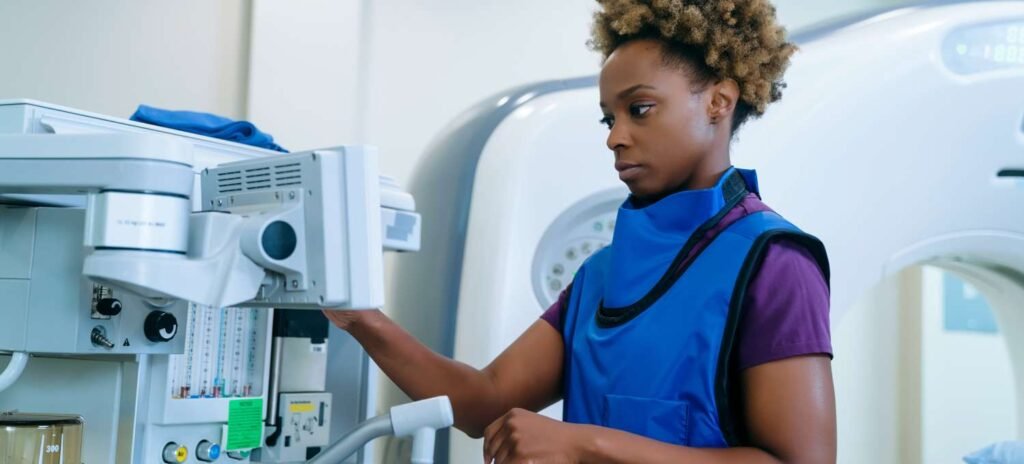Are you fascinated by the inner workings of the human body and eager to play a crucial role in healthcare? If so, stepping into the world of radiology technology might just be your calling. Radiology technicians, also known as radiologic technologists, are essential members of medical teams who specialize in capturing images of the body to aid in diagnosing illnesses and injuries. In this blog post, we will explore how you can embark on a rewarding career path as a radiology tech, from education requirements to job outlooks and beyond. So fasten your seatbelts and get ready to explore the fascinating field of radiology!
The Importance of Radiology Technicians

In the realm of healthcare, radiology technicians hold a vital position in the diagnostic process. These skilled professionals are adept at operating sophisticated imaging equipment to produce high-quality images that help doctors pinpoint illnesses and injuries. From X-rays to MRIs, radiology techs play a crucial role in providing accurate visual insights into patients’ conditions.
Their work directly impacts treatment decisions and patient outcomes, making them indispensable members of medical teams across various specialties. Radiology technicians possess the technical expertise to manipulate imaging tools effectively while ensuring patient comfort and safety during procedures. Their keen eye for detail and precision is instrumental in producing clear and precise images that aid physicians in formulating accurate diagnoses.
As technology advances rapidly, radiology technicians must stay abreast of the latest innovations to deliver top-notch services and contribute significantly to enhancing healthcare delivery.
Steps to Becoming a Radiology Tech
Interested in becoming a radiology tech? Here are the steps you need to take to pursue this rewarding career path.
Focus on meeting the education and certification requirements. Typically, this involves completing a formal training program at an accredited institution. This can be a certificate program, an associate degree, or even a bachelor’s degree in radiologic technology.
Next, practical training and experience are crucial. Many programs include clinical rotations where students gain hands-on experience working with patients and imaging equipment under supervision.
After completing your education and training, it’s time to obtain any required certifications or licenses needed to practice as a radiology technician in your state. This may involve passing exams administered by professional organizations like the American Registry of Radiologic Technologists (ARRT).
Keep in mind that continuing education is often necessary to maintain certification and stay current with advancements in the field of radiology technology. By staying proactive and engaged, you can set yourself up for success as a skilled and knowledgeable radiology tech.
See Also: How much Earn an X-Ray Tech?
Education and Certification Requirements
Embarking on a career as a radiology tech starts with the right education and certification. To become a radiologic technologist, you typically need an associate’s or bachelor’s degree in radiography. These programs cover anatomy, patient care, radiation physics, and medical imaging techniques.
After completing your formal education, the next step is to obtain certification. Most employers require radiology techs to be certified by the American Registry of Radiologic Technologists (ARRT). This entails passing a test that evaluates your expertise in the field.
Continuing education is often necessary to maintain certification and stay up-to-date with advancements in technology and practices within the field. Some states may also have specific licensing requirements that you’ll need to fulfill.
Dedication to learning and honing your skills is key for success. The combination of academic knowledge and practical experience gained through internships or clinical rotations will prepare you for a rewarding career in healthcare imaging technology!
Practical Training and Experience
Practical training and experience are crucial components of becoming a skilled radiology tech. This hands-on aspect allows aspiring technicians to apply their theoretical knowledge in real-world settings.
During this phase, students often work under the supervision of experienced professionals to gain practical skills in operating imaging equipment, positioning patients correctly for scans, and ensuring high-quality images are produced.
Through these experiences, learn how to communicate effectively with patients during procedures, providing reassurance and maintaining patient comfort throughout the process. Additionally, they develop the ability to adapt quickly to different situations that may arise in a fast-paced healthcare environment.
By actively participating in various imaging procedures and observing seasoned technologists, students can refine their techniques and hone their problem-solving abilities. This exposure is invaluable in preparing them for the diverse challenges they may encounter once fully qualified as technicians.
Job Outlook and Salary Potential for Radiology Techs

The job outlook for radiology techs is promising, with a projected growth rate higher than the average for all occupations. As the healthcare industry continues to expand, the demand for skilled imaging professionals also rises. This trend opens up various opportunities for those interested in pursuing a career in radiology technology.
In terms of salary potential, radiology techs can expect competitive pay that reflects their specialized skills and expertise. The median annual wage for radiologic technologists surpasses many other allied health professions. With experience and additional certifications, individuals can further enhance their earning potential in this field.
The combination of favorable job prospects and attractive salaries makes becoming a radiology tech an appealing choice for those looking to enter a dynamic and rewarding healthcare profession.
What Skills and Qualities Needed for Success in this Field?
As a radiology tech, possessing a blend of technical skills and personal qualities is crucial for success in this field. First and foremost, attention to detail is paramount; the ability to notice even the smallest abnormalities on an x-ray can make a significant difference in patient care.
Additionally, strong communication skills are essential when interacting with patients who may be anxious or in pain. Being able to explain procedures clearly and empathetically can help ease their concerns and build trust.
Technical proficiency in operating complex imaging equipment is also vital. Understanding how to position patients correctly for scans and adjust machine settings ensures accurate results that aid physicians in diagnosing medical conditions.
Conclusion
In a constantly evolving healthcare landscape, radiology technicians play a crucial role in diagnosing and treating patients. The demand for skilled radiology techs is on the rise, offering rewarding career opportunities with competitive salaries.
By following the steps outlined in this guide, including obtaining the necessary education and certification, gaining practical experience, and honing essential skills and qualities, aspiring individuals can embark on a fulfilling journey towards becoming a successful radiology tech.
With advancements in technology leading to new specializations within the field of radiology, there are endless opportunities for growth and professional development. Despite facing challenges such as long hours and potential exposure to radiation, dedicated radiology techs continue to make significant contributions to patient care.


